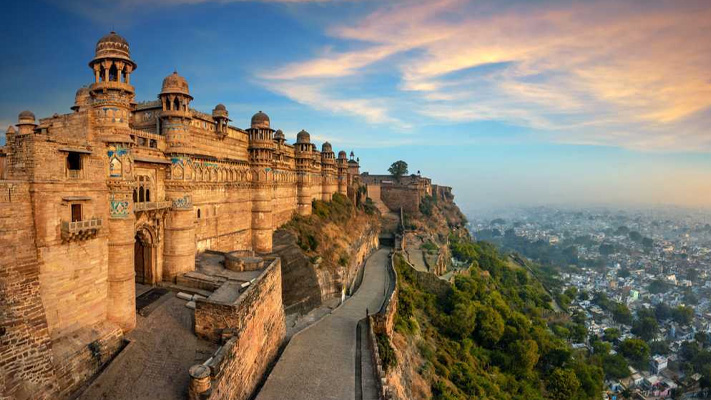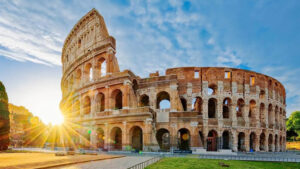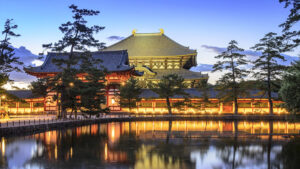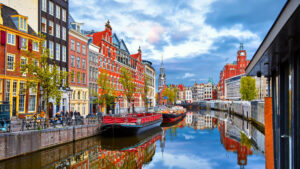GWALIOR, MADHYA PRADESH – WHERE HISTORY UNFOLDS IN MAJESTIC SPLENDOUR

Located in the heart of Madhya Pradesh, Gwalior stands as a captivating tourist destination that seamlessly blends history, culture, and natural beauty. With its majestic fort, ancient temples, opulent palaces, and scenic landscapes, Gwalior offers a journey through time and a glimpse into the grandeur of its royal past. This city, steeped in rich heritage, is known for its architectural marvels, vibrant music traditions, and warm hospitality. From exploring the towering Gwalior Fort to immersing oneself in the melodies of Indian classical music, Gwalior promises an enchanting experience that leaves visitors in awe. Whether it’s the ornate palaces, serene temples, or the scenic surroundings, Gwalior beckons travelers with its tales of valor, artistic brilliance, and cultural treasures.

Here’s an overview of what makes Gwalior worth visiting:
- Majestic Fort: Gwalior Fort is one of the most prominent attractions in the city. Built on a hilltop, it offers panoramic views of the city and houses magnificent palaces, temples, and structures that reflect the grandeur of the bygone era. The fort is also famous for its unique architecture and intricate carvings.
- Scenic Splendor: Gwalior is surrounded by picturesque landscapes, including rocky hills, lush green forests, and tranquil lakes. Places like Tansen Park, Gopachal Parvat, and Tigra Dam provide serene environments for relaxation and leisurely walks.
- Historic Temples: Gwalior is home to several ancient and revered temples. The Sas Bahu Temples, dedicated to Lord Vishnu, showcase intricate carvings and are architectural marvels. Other notable temples include the Teli Ka Mandir, dedicated to Lord Vishnu, and the Sun Temple, known for its beautiful idol of the Sun God.
- Jai Vilas Palace: Jai Vilas Palace is a splendid palace built during the reign of the Scindia dynasty. It showcases a blend of European and Indian architectural styles and boasts opulent interiors. The palace also houses the Scindia Museum, which exhibits a vast collection of artifacts, weapons, and antique items.
- Music and Culture: Gwalior has a rich musical heritage and is considered the birthplace of several prominent Indian classical musicians. The city hosts the annual Tansen Music Festival, a renowned event that attracts maestros and music lovers from around the world.
- Museums and Galleries: Gwalior has several museums and art galleries that offer insights into the city’s history, culture, and art. The Gujari Mahal Archaeological Museum houses a diverse collection of artifacts, including sculptures, coins, and paintings.
- Shopping and Cuisine: Gwalior offers a vibrant shopping experience with its bustling markets, where you can find traditional handicrafts, textiles, and jewelry. Don’t miss trying the local delicacies, including the famous Gwalior kebabs and traditional sweets like petha.
- Annual Festivals: Gwalior celebrates various festivals with great enthusiasm. The Tansen Music Festival, Gwalior Trade Fair, and Navratri celebrations are some of the popular events that showcase the city’s cultural vibrancy.
Gwalior’s rich history, architectural marvels, musical heritage, and natural beauty make it a captivating destination for history buffs, culture enthusiasts, and nature lovers. With its mix of heritage sites, artistic treasures, and warm hospitality, Gwalior offers a unique and memorable travel experience.
Activities for Tourists
There are plenty of activities for tourists to enjoy in Gwalior. Here are some popular ones:

- Explore Gwalior Fort: Begin your Gwalior adventure by exploring the majestic Gwalior Fort. Wander through its sprawling complex, visit its palaces, temples, and museums, and soak in the panoramic views of the city from its vantage points.
- Visit Jai Vilas Palace and Scindia Museum: Discover the grandeur of the Jai Vilas Palace, the residence of the Scindia dynasty. Explore its opulent interiors, adorned with chandeliers, artwork, and royal artifacts. Don’t miss the Scindia Museum within the palace, which showcases a vast collection of artifacts, including weapons, vintage cars, and historical memorabilia.
- Witness the Sound and Light Show: Experience the captivating Sound and Light Show at the Gwalior Fort, where the history of the fort and the city comes alive through illuminations, sound effects, and narration. It’s a mesmerizing way to learn about the city’s rich past.
- Attend the Tansen Music Festival: If you visit Gwalior in December, don’t miss the renowned Tansen Music Festival. Named after the legendary musician Tansen, the festival features classical music performances by eminent artists from India and abroad. Immerse yourself in the soulful melodies and rhythms of Indian classical music.
- Explore Temples: Gwalior is home to several ancient and revered temples. Visit the Sas Bahu Temple, known for its intricate carvings and architectural beauty. Pay a visit to the Teli Ka Mandir, a unique temple with a blend of architectural styles. Experience the spirituality and tranquility of these sacred sites.
- Enjoy Shopping and Local Cuisine: Explore the bustling markets of Gwalior and indulge in some shopping. From traditional handicrafts, textiles, and jewelry to delicious local snacks and sweets, the markets offer a vibrant shopping and culinary experience.
- Discover the Gwalior Trade Fair: If you visit during the winter months, the Gwalior Trade Fair is a must-visit. It is a popular annual fair that showcases the rich culture, traditions, and craftsmanship of the region. Enjoy the lively atmosphere, cultural performances, food stalls, and shopping opportunities.
- Visit Museums and Art Galleries: Immerse yourself in Gwalior’s history and art by visiting its museums and art galleries. Apart from the Scindia Museum, explore the Gujari Mahal Archaeological Museum, which houses a remarkable collection of artifacts and sculptures.
Top Attractions and Must Visit Places
Gwalior offers a plethora of attractions and must-visit places that showcase its rich history, architectural marvels, and cultural heritage. Here are some of the top attractions in and around Gwalior:
- Gwalior Fort: Dominating the city’s skyline, Gwalior Fort is a UNESCO World Heritage Site and a must-visit attraction. Explore its massive walls, palaces, temples, and museums, including Man Mandir Palace, Gujari Mahal, and the Archaeological Museum.

- Jai Vilas Palace: Discover the opulence of the Jai Vilas Palace, the residence of the Scindia dynasty. Admire its grand architecture, lavish interiors, and the Scindia Museum, which displays a remarkable collection of artifacts and royal memorabilia.
- Sas Bahu Temple: This intricately carved temple complex dedicated to Lord Vishnu is a testament to the exquisite artistry of the bygone era. Marvel at the detailed sculptures and the architectural beauty of this ancient temple.
- Teli Ka Mandir: Standing tall as the highest structure in Gwalior Fort, Teli Ka Mandir is a blend of North Indian and South Indian architectural styles. Admire its unique architecture and enjoy panoramic views of the city from its elevated location.
- Sun Temple: Located near the Residency at Morar, the Sun Temple is a modern architectural marvel. Dedicated to the Sun God, it features a stunning idol of the deity and intricate carvings.
- Gujari Mahal Archaeological Museum: Explore the Gujari Mahal Archaeological Museum, housed within the Gwalior Fort. It displays a wide range of artifacts, including sculptures, coins, paintings, and other archaeological finds.
- Tomb of Tansen: Pay homage to the legendary musician Tansen at his tomb located in the Tomb of Tansen complex. It is a serene place and a popular spot for music lovers.
- Tighra Dam: Situated on the outskirts of Gwalior, Tighra Dam is a picturesque reservoir offering opportunities for boating, picnicking, and enjoying scenic views of the surrounding hills and water.
- Padavali and Bateshwar Temples: Take a short trip from Gwalior to explore the ancient temple complexes of Padavali and Bateshwar. These temples are known for their intricate carvings and historical significance.
- Gopachal Parvat: Located near Gwalior Fort, Gopachal Parvat is a serene hill known for its Jain sculptures carved into the rock face. It offers a peaceful retreat and a chance to admire the ancient art forms.
Best Time to Visit
The best time to visit Gwalior is during the winter season, which lasts from October to March. The weather during this period is pleasant, with temperatures ranging from 10°C to 25°C (50°F to 77°F). It is the ideal time for sightseeing and outdoor activities as the weather is mild and comfortable.
Here are some reasons why winter is considered the best time to visit Gwalior:

- Pleasant Weather: The winter season in Gwalior offers a reprieve from the scorching heat of the summer months. The temperatures are mild, making it comfortable for exploring the city’s attractions and engaging in outdoor activities.
- Festivals and Events: Gwalior hosts several cultural festivals and events during the winter months. The Tansen Music Festival, held in December, attracts renowned classical musicians from around the country, providing a delightful experience for music enthusiasts.
- Clear Visibility: Winter is characterized by clear skies and reduced humidity, ensuring better visibility of Gwalior’s architectural marvels and panoramic views from viewpoints like Gwalior Fort.
- Comfortable Outdoor Activities: With pleasant temperatures, winter is an excellent time for outdoor activities in Gwalior. Whether it’s exploring the forts and palaces, visiting temples, or enjoying boat rides on Tighra Dam, the weather conditions are favorable for outdoor adventures.
- Shopping and Festive Season: Winter is the festive season in Gwalior, with celebrations such as Diwali and Navratri. The markets are bustling with activity, offering a vibrant shopping experience with local handicrafts, textiles, and traditional items.
While winter is the best time to visit Gwalior, it is important to note that the city can experience cold temperatures during December and January. It is advisable to carry adequate warm clothing to stay comfortable during the cooler evenings and early mornings.


















































